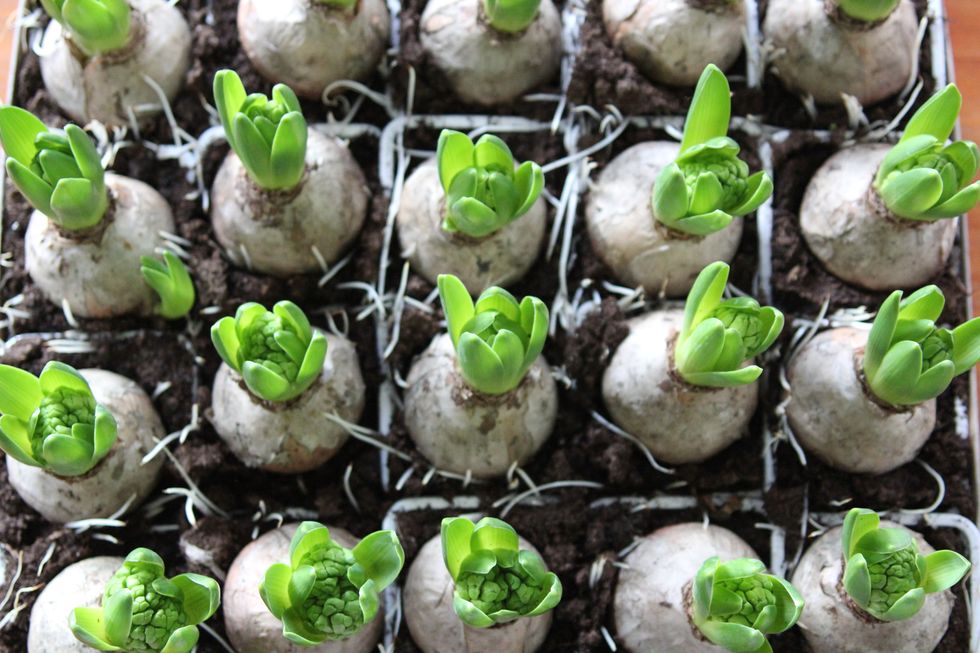
By ADRIAN SELLARS
CountryLiving.com
PHOTO CREDIT: G. MERRIL/GETTY IMAGES
A guide to what to do in the garden in November, including flower and plant preparation and planting, vegetable patch jobs and general maintenance. Now’s the season for woolly jumpers, cosy fires and comfort foods. Outside, the garden glows with autumnal color. Dogwood sets borders alight with its fiery stems. Delicate cyclamen bloom beneath sleepy trees. Newly-potted containers hold the potential of winter color, while spring bulbs are preparing for their moment in the sun. It’s worth remembering that a little time spent in the garden now will pay dividends over the coming months.
FLOWERS
1. CUTBACK AND MULCH PERENNIAL PLANTS
Perennial plants will have seen better days, so cut stems to just above the ground and apply a mulch around the base of the plant, to protect the roots and suppress weeds. These plants can also be lifted, divided and replanted, increasing your flower stock for next year. You can also lift and store dahlias.
2. PLANT SPRING BULBS AND TULIPS
November’s a good time to plant tulip bulbs, whether in the ground, pots or containers. Avoid any that show signs of decay or damage, and plant three times to the depth of the bulb. If the soil is heavy, add grit for drainage as bulbs don’t like to sit in water.If you’re feeling creative, try ‘lasagne’ planting, by layering spring bulbs according to their flowering period. For example, at the bottom of your pot, plant tulip bulbs which are usually the last to flower. Cover them over with soil then plant a layer of bulbs which flower before tulips, such as daffodils. Cover over and continue the process finishing with an early blooming bulb, like snowdrops. It’s a great way to get the most from one pot and gives you continuous color throughout spring.
3. SHOP AND PLANT WINTER FLOWERING PLANTS
But why wait until spring for colour, when you can have it throughout winter? Most garden nurseries will now be stocked with winter pansies, polyanthus and primroses. Consider planting these outside your windows, beside pathways, or just outside your door so you can easily appreciate your floral displays throughout the season. Hanging baskets, window boxes and patio pots are ideal for showcasing these winter blooms.
4. SHOP AND PLANT BARE ROOT ROSES, SHRUBS AND TREES
November to March is a dormant period for roses, shrubs and trees (including fruit trees such as pear and apple). They’re often sold as bare roots which are easier on the pocket compared to their potted counterparts.Before planting out, place your bare root plant into a bucket of water for half an hour to rehydrate. Ensure the growing area is free of weeds and large stones. Dig a hole large enough to accommodate the roots. Break up the soil base with a fork before adding a spadeful of well-rotted organic matter mixed with soil. Place plant upright in the centre of the hole, backfill, firm-in well and water. Finally, add a layer of mulch around the base of the plant.
VEGETABLES
5. ADD WELL-ROTTED MATTER TO EMPTY VEGETABLE BEDS
If your veg beds are lying empty over winter, cover them over with well-rotted organic matter. During the colder months it will breakdown, releasing valuable nutrients which will improve fertility and soil structure.
6. LIFT CROPS CAREFULLY
A hard frost improves the flavor of parsnips, swede and Brussels sprouts, as it converts their starches into sugars. If you are lifting these on a cold day, make sure you do it with a hand fork, carefully prising them from the soil.
7. COVER BRASSICAS WITH NETTING
Keep brassicas covered with netting, as hungry pigeons will see them as a food source.
8. STAKE PLANTS TO PREVENT WIND ROCK
Finally, stake purple sprouting broccoli and Brussels sprouts, as they can be top-heavy plants.
FRUIT
9. APPLY GLUE BANDS TO FRUIT TREES
It’s a good idea to wrap glue bands around the base of fruit trees for protection. Pests, such as the winter moth caterpillar, will be looking for shelter, laying their eggs and eating fresh tree shoots.
10. TEND TO YOUR BERRIES AND CURRANTS
Autumn-fruiting raspberry canes can be cut down to just above the soil line, whilst strawberry beds can be tidied by cutting away old foliage and removing runners and weeds. Gooseberry, blackcurrant and red currant bushes can also be pruned. This will help with ventilation and prevent pests and diseases.
GENERAL MAINTENANCE
11. GIVE YOUR TOOLS AN MOT
Garden tools should be cleaned and sharpened after a season of use. Ensure all lawn mowers have been cleaned, checked, and drained of fuel.
12. CLEAN THE GREENHOUSE
Tidy greenhouses by disposing of old plants, and removing and cleaning pots. Clean the glass with warm soapy water. If you’re leaving stone or terracotta pots outside over winter, make sure they’re standing on clay feet or bricks to avoid frost damage and to help with drainage.
13. GET WILDLIFE READY FOR WINTER
Finally, give garden wildlife a helping hand by filling bird feeders and leaving a fresh water supply. Try building insect hotels by drilling holes in old logs, or leave a corner of the garden wild, allowing creatures somewhere to rest over winter.
